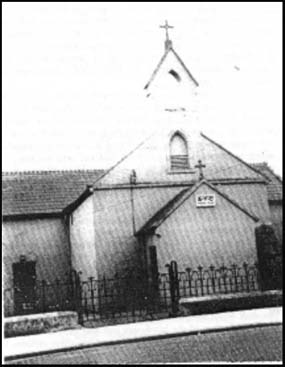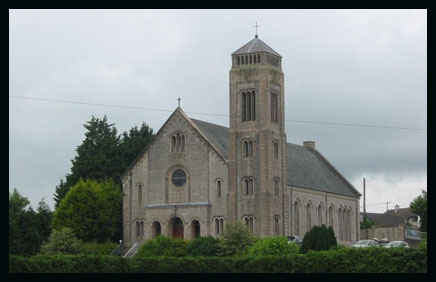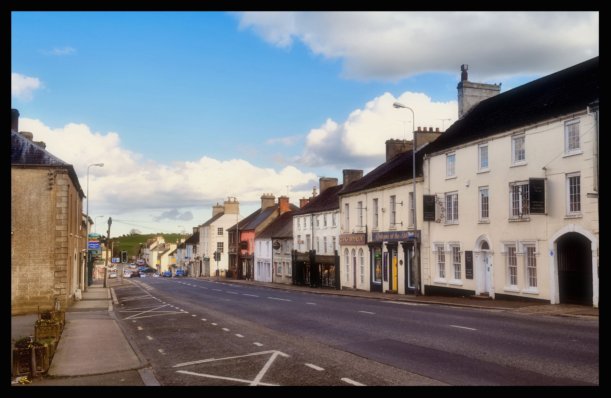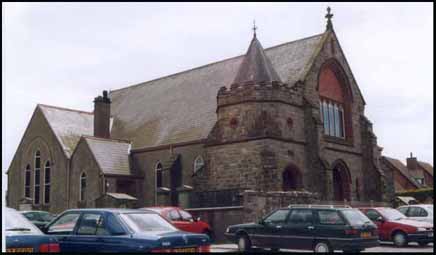|
Ros
Davies' Co.
Down, Northern Ireland Family History Research Site
© Rosalind Davies 2001 Permission granted to reprint research for non-profit use only |
Saintfield Parish
| Saintfield town | Church of Ireland | 1st Presbyterian Church |
| 2nd Presbyterian Church | old Catholic Church | 'new' Catholic Church |
| Rev.Thomas Ledlie Birch of 1st Presbterian Church | . | . |
In 1837 there were 464 males &
592 females living in and around the town. The land was of the best
quality and the farms in the townland were from 5 - to acres with a
rent of 30-35 shillings an acre; the proprietor was Mr. Price, who owned
most of the land in this parish. The seat of the lord of the manor (
the Price family) is situated in a beautiful demesne, about a mile north
of the town; as is also the seat of the late Rev. G.R. Moore , Rowallen,
who expended many thousands of pounds in planting trees and shrubs.
The parish population in 1846 was 7156 with 909 residents in the town
& by 1851 there were 501 males & 603 females in the town(POD).
By 1910, the parish population was 3073 with 554 in the town. In 1892, Petty Sessions were held on first Tuesday of each month and the market was held every Monday and the fair on the last Wednesday of each month. Catholic Parochial House here . Saintfield Cricket Team 1906 (photo DS 2008 p69) Click here for more information on the schools here in 19th century. Click here for a photo & story of the railway station. Newspaper article from Northern
Star; Newspaper articles from Down
Recorder; Newspaper article from Newtownards
Independent; Newspaper article from Newtownards
Chronicle; |
||||
| References;V17 p 120 & V7 p 114-120 OSM;POD; DR 5/11/03 ; SHM '86 p 4,5; O'L V1 p 371, 409; WAS ; DS |
|
Newspaper articles from Down
Recorder; Records available are; baptisms 1724- 1754, marriages 1724- 1750, burials 1724- 1750 ; graveyard attached , gravestones UHF Vol 3; email me for a gravestone look-up The vicars of Saintfield: 1633; James Ferguson There has always been a very close
connection between the Price family and the Saintfield Church of
Ireland: |
| References;MS WAG page 5: DR; 7 p 114, 115 ,119 OSM; SHM '94 p37,39 & '86 p 9, 29 & '98 p 58 & '90 p 29; GIPR: GIC; O'L V1 p 372 |
The dimensions of the new meeting house were 50 by 70 feet and capable of holding 900 people. There was scarcely enough room to hold the increasing congregation. Rev. Henry Simpson, whose salary was £100 a year from the government and £81 a year from the congregation remained until 1843 then Rev. James Wallace until 1846 then Rev. Robert McEwen 1846-1853 then Rev. Samuel Hamilton 1854 until his death in 1849. The new pulpit erected in the church
in 1890 was constructed by a local craftsman names James Stevenson,
though commonly called Jamie Steenson. He lived alone in a small stone
cottage which he built himself in a little glen, now in Mr. John Beattie's
farm at Carsontown Road, Lisowen. He owned two fields there and his
cottage , now in ruins, consisted of a sizeable workshop having a very
large doorway with glass panels and a living room above which was a
bedroom. In 1892 the Rev. Stewart Dickson (minister for 56 years) organised a guild which professed to foster a healthy and stimulating fellowship, to be educational and to afford opportunity for an exchange of views on matters religious and social. The Guildhall was opened on 20th November 1901, beside the 1st Presbyterian Church, to accommodate all the members of the Guild. It is a large, two-storey building which now serves as the church hall. Here is a list of the 10 ministers
up to 1837. Names are: Newspaper article from Northern
Star; Newspaper article from Down Recorder; Newspaper article from Newtownards
Chronicle; Records from 1851, graveyard attached , gravestones UHF Vol 3; email me for a gravestone look-up ; For a history see http://www.lisburn.com/books/1-2-boardmills-killaney/boardmills-killaney-2.htm#Secession |
||||
| References;HCPCI p227-228; NS: MS WAG p 6, 7 : DR; V7 p 114, 115, 119 OSM; GIPR: GIC: POD; SHM '94 p 57, 58,10,56 & '86 p 9, 29 & '98 p 23, 27, 28, 29; NC; DR* |
1798 Rebellion & Rev Thomas Ledlie Birch
|
The tablet on 1st Presbyterian Church,
Saintfield reads; I am of the option that most people worshipping in Saintfield Presbyterian Church since its erection in 1777 have paused and read this inscription on what is the original gable wall and further have pondered over its truth and application. But what of the man, Thomas Ledlie Birch, Dissenting Minister of Saintfield
and United Irishman? During these eventful years Thomas Birch had decide, like his older brother , to enter the ministry and so in 1770 he became a student at Glasgow University, graduation in 1772. When the minister of the Presbyterian Church in Saintfield, Rev. Richard Walker, died in 1774, the congregation applied for a hearing of Mr. Birch. It was not until 21st May 1776 that his ordination by the Presbytery of Belfast took place in Saintfield , one of the largest Presbyterian congregations in Ireland at that time. A young man aged 21 he entered vigourously into his pastoral work. Within a year he had encouraged his congregation to build a new church costing £700, a debt not cleared for some seven or eight years. In 1783 Birch married his second cousin, Isabella Ledlie of Arboe. The following year he bought a farm at Ballycloghan and named it Liberty Hill, a name it bears to this day. His choice of name indicated his interest in political affairs. In the same year, he was associated with a congratulatory address to George Washington expressing satisfaction that American had cast off the yoke of slavery. The French Revolution broke out in 1789 and its ideals of 'Liberty, Equality and Fraternity' aroused Irish radicalism anew. Catholic emancipation and parliamentary reform were the political ideals central to the thinking of the 'Society of the United Irishmen' founded in Belfast in 1791. Within a year the Society had launched a newspaper, the 'Northern Star' to disseminate the views of the movement. Birch was enthused by this and formed "Society of United Irishmen' on January 16th 1792. In the pulpit he preached freedom and liberty and through his influence most of the congregation became enthusiastic supporters of his radical ideas. His congregation on Christmas Day 1792 held a meeting and passed resolutions that Government should be by the people and that the form of government in being at that time had many errors because of the lack of representation of the people in the Commons House. Birch frequently wrote a "Letter from Saintfield' to be published in the Northern Star. His opinions and statements became more extreme as revealed in a sermon preached to fellow Masons in 1795 in which he declared 'kings to be the butchers and scourges of the human race, revelling in the spoils of thousands, whom they had made widows an orphans.' Britain went to war with France in 1793 and as a consequence the Societies of United Irishmen were soon being suppressed as they were regarded as traitorous- the administration of the oath becoming as capital offence. The societies or clubs were driven underground and soon armed revolt was being considered. Many left the movement on seeing it move towards a republican extreme; those remaining being more militant. By 1795 , a number of Mr. Birch's congregation, who either disliked his political sympathies, or his preaching, along with a group from Boardmills, sent a partition requesting 'supply of sermon' to the Associate Presbytery of Down. This was approved and so was formed a Burgher Secession congregation (now 2nd Saintfield); the Church building being completed in 1796. Mr. Birch was enraged and he poured his wrath into a pamphlet entitled 'Physicians languishing under disease (Luke 4 v 23)- An address to the Seceding or Associate Synod of Ireland.' This polemic is so outrageous that one can gauge how extreme his opinions had become. Birch's actions and opinions were not going unnoticed. In April 1797 Squire Nicholas Price of Saintfield Estate ,a magistrate and loyalist intent on hounding the United Irishmen, had Mr. Birch arrested in the courtroom at Down Assizes on a charge of high treason ,a capital offence. Birch was attending a trial of eleven of his congregation who were acquitted of attacking the home of Hugh McKee, a local loyalist. After three days confinement Birch was released on bail to appear at the Autumn Assizes, the charge being reduced to misdemeanor, a crime punished by transportation. John Curragh, who owned the neighbouring farm to Mr. Birch, declared on oath Mr. Birch had made seditious statements to him on two occasions. This was disproved by the prisoner's witnesses and Curragh's integrity and character were impugned in spite of Squire Nicholas Price and the Rev. James Clewlow, vicar both stating to the court that Curragh's oath was creditable. Birch was found not guilty. The years 1796-1798 were perilous tears. Arson, assaults, intimidation and even murder were commonplace. Any person proved to having administered the United Irishman's oath was hanged. William Orr of Farranshane, Co. Antrim, hanged in October 1797, was the most notable case. It was not long before Birch was again in court. This time he was accused of offering Joseph Harper £50 not to prosecute United Irishmen and also with an assault on Harper's son. He appeared at the Assizes in April 1798 but the prosecution was dropped as Joseph Harper was dead, having been shot the Tuesday previous on the Belfast Road. Birch was again discharged. Birch, it is believed, took part in the Battle of Saintfield on Saturday, 9th June, 1798, when the Untied Irishmen of North Down, who had gathered at Saintfield, forced the government troops to retreat to Comber. On the following day Sunday, 10th June, known as Pike Sunday, the main body of the insurgents was at Creevy Rocks and Birch is reported as preaching to them from the text Ezekial 9 v1. It is strange that in the subsequent court-martial of Birch, 18-20 June, although evidence is given that he was at Creevy Rocks, no mention is made of him preaching a sermon. Indeed Birch brought evidence that he was attending the funeral of a child on Sunday afternoon. From evidence given at the court-martial, Birch on Monday 11th had spent the early part of the day in burying dead soldiers. An insurgent passing through Saintfield watched the dead soldiers being buried was was horrified to see their bodies 'thrown on a cart like dead dogs and cast carelessly into a large pit.' Their burial place is known as York Island, immediately at the foot of the Church graveyard (photo of this gravestone available) I am of the opinion that this, no longer an island, is on the river side of the trees below the two rebel graves. The bodies of the rebels killed in the skirmish were either taken to their more distant home or buried in Saintfield on the Sunday. It is interesting to note in the evidence given in the court-martial that Mr. Birch took his sexton and others helping o bury the dead soldiers to McCreery's shop [ where he purchased liquor as refreshment for them. The United Irishmen's army was routed at the Battle of Ballynahinch on Wednesday, 13th June. There followed a brief period of terror as rebels were ruthlessly hunted down and vengeance executed. Birch was not free for long, being arrested on Saturday, 16th June and court-martialled in Lisburn as already stated on 18th June, a trial lasting three days. The Rev. Thomas Birch had a brother, Dr. George Birch of Newtownards, a staunch Royalist and Commander of the town's Yeomanry Cavalry. Dr. George Birch was fortunate in being a great friend of Lord Castlereagh and using his influence he could assure his brother that he would be acquitted if he would voluntarily offer to go into exile. Birch followed his brother's advice and addressed the court in a conciliatory manner saying he would quit his Majesty's Dominions. The court found that the evidence was not strong enough to affect the prisoner's life and therefore acquitted him of the crimes of treason and rebellion laid to his charge. He was kept in custody in Lisburn where a disgruntled party of Yeoman were intent in taking him out to hang him but were prevented from doing so by dragoons. Presumably this threat to his life hastened his transfer to Belfast two days later where eventually he was incarcerated in a prison ship on 19th July, 1798. On the same date he sold his Ballycloughan farm to another brother, Rev. James Birch for £500. The following March his brother sold the farm for £1,111 to a Listooder man. Conditions on board an overcrowded ship with no headroom, poor food, hot summer weather and little light and ventilation must have been intolerable. Undoubtedly it was a relief to be released on 16th August 1798 and allowed to sail to New York where he arrived in September. His life in America was not without setbacks and strike. He settled in Washington, Pennsylvania, but found the local presbytery would not accept him. Further attempts were unsuccessful, even an appeal to the general Assembly proved inconclusive. Litigation in the Supreme Court in an action of slander against another Presbyterian clergyman resulted in defeat for Birch. However he was finally accepted as a member of the Presbytery of Baltimore and presumably became a minister of a congregation in or near Washington, Pa, as he had purchased a farm a few miles out of the city. He died in April 1828. His widow died in November 1836 and a son Hamilton died in March 1847. Another son, Thomas Ledlie, remained in Saintfield and is buried in the graveyard behind the church. His headstone is inscribed 'Thomas Ledlie Birch, son of the Rev. Thomas Ledlie Birch, once the faithful beloved pastor of Saintfield, in whom there was no guile. 1820." by James McIlhinney- published in "Saintfield Heritage " in 1998 pages21-25 |
Call for a new Presbyterian minister- 1798
|
Following the defeat of the United Irishmen at the Battle of Ballynahinch in the 1798 Rebellion, the Rev. Thomas Ledlie Birch, the Presbyterian minister in Saintfield and a prominent United Irishman, had to leave the country and went to America. The letter reproduced below was an invitation to Mr. Henry Simpson to replace Rev. Birch. The letter had over 100 signatures, all, except for the Widow Fleming, male and quite a few of the names still exist in the Saintfield district today. To Mr. Simpson, preacher of the Gospel. Sir, Signed by: I was present when the within call was unanimously
subscribed. |
|
An Account of Church Discipline in the Reformed Presbyterian Church, in 1868 In the year 1868 the Session of the Reformed Church not far from Saintfield had before it a case of Church discipline. The record reads as follows..... "The case of ............ was brought before the Session charged with gambling. It was stated he had publickly engaged in a game of chance some weeks past on his return home from a fair in Saintfield. The charge was admitted and the details of the case given by him most candidly. He professed his sorrow for the sin into which he had inadvertently been drawn and his willingness to submit to whatever might be the decision of the Session in his case. Being requested to withdraw, the Session after mutual consultation, agreed that on account of the nature of the offence and the publick manner in which it had been committed that publick censure should be administered. This was done accordingly by the Moderator of Session at the close of the first publick service, accompanied by an exposure of the evils of gambling in its manifold forms and warning both the offender and all others present against it." "The same Session in 1882 , gave its approval to efforts to preserve
the purity of religious worship and keep out the unscriptural innovation
of Instrumental Music in the publick praises of the Sanctuary." During a special service in 1890 it was noticed that the balcony was swaying. Rev. Robert McElney, who was minister at the time, set off to the United States of America, armed with the names of those who had emigrated from the Saintfield District. He visited these people and was able to return to Saintfield with sufficient donations to enable the new church to be erected on the site of the old building. The foundation was laid in 1892 and the church was known as Second Presbyterian Church, also as the Meeting House. Newspaper article from Banner
of Ulster; Records from 1831 (baptisms) & 1837 (marriages); graveyard attached, gravestones UHF Vol 3 (oldest stone 1803) |
| References;V7 p 114, 115 ,119 OSM; GIC: GIPR ; POD; SHM '94 p60 & '86 p 31, 9 & '98 p 23; MIs |
 |
|
||
 |
|
||
by Ros Davies



